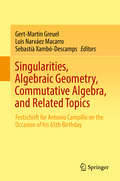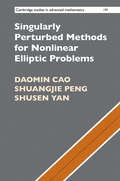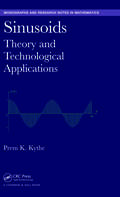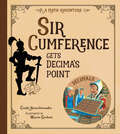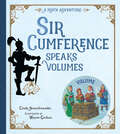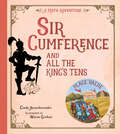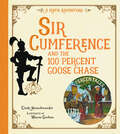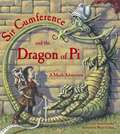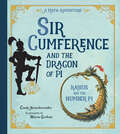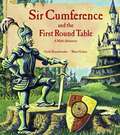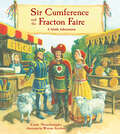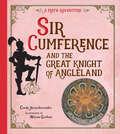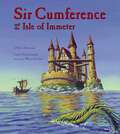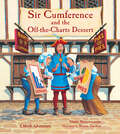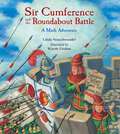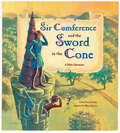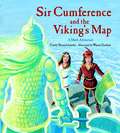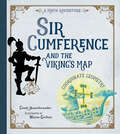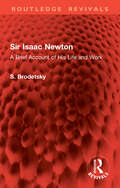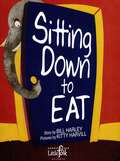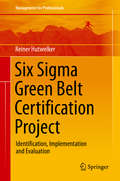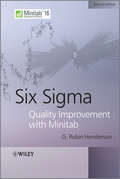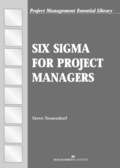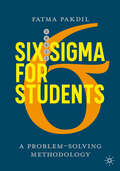- Table View
- List View
Singularities, Algebraic Geometry, Commutative Algebra, and Related Topics: Festschrift for Antonio Campillo on the Occasion of his 65th Birthday
by Gert-Martin Greuel Sebastià Xambó-Descamps Luis Narváez MacarroThis volume brings together recent, original research and survey articles by leading experts in several fields that include singularity theory, algebraic geometry and commutative algebra. The motivation for this collection comes from the wide-ranging research of the distinguished mathematician, Antonio Campillo, in these and related fields. Besides his influence in the mathematical community stemming from his research, Campillo has also endeavored to promote mathematics and mathematicians' networking everywhere, especially in Spain, Latin America and Europe. Because of his impressive achievements throughout his career, we dedicate this book to Campillo in honor of his 65th birthday. Researchers and students from the world-wide, and in particular Latin American and European, communities in singularities, algebraic geometry, commutative algebra, coding theory, and other fields covered in the volume, will have interest in this book.
Singularities: Formation, Structure, and Propagation
by J. Eggers M. A. FontelosMany key phenomena in physics and engineering are described as singularities in the solutions to the differential equations describing them. Examples covered thoroughly in this book include the formation of drops and bubbles, the propagation of a crack and the formation of a shock in a gas. Aimed at a broad audience, this book provides the mathematical tools for understanding singularities and explains the many common features in their mathematical structure. Part I introduces the main concepts and techniques, using the most elementary mathematics possible so that it can be followed by readers with only a general background in differential equations. Parts II and III require more specialised methods of partial differential equations, complex analysis and asymptotic techniques. The book may be used for advanced fluid mechanics courses and as a complement to a general course on applied partial differential equations.
Singularly Perturbed Methods for Nonlinear Elliptic Problems (Cambridge Studies in Advanced Mathematics)
by Daomin Cao Shuangjie Peng Shusen YanThis introduction to the singularly perturbed methods in the nonlinear elliptic partial differential equations emphasises the existence and local uniqueness of solutions exhibiting concentration property. The authors avoid using sophisticated estimates and explain the main techniques by thoroughly investigating two relatively simple but typical non-compact elliptic problems. Each chapter then progresses to other related problems to help the reader learn more about the general theories developed from singularly perturbed methods. Designed for PhD students and junior mathematicians intending to do their research in the area of elliptic differential equations, the text covers three main topics. The first is the compactness of the minimization sequences, or the Palais-Smale sequences, or a sequence of approximate solutions; the second is the construction of peak or bubbling solutions by using the Lyapunov-Schmidt reduction method; and the third is the local uniqueness of these solutions.
Sinusoids: Theory and Technological Applications
by Prem K. KytheA Complete Treatment of Current Research Topics in Fourier Transforms and Sinusoids Sinusoids: Theory and Technological Applications explains how sinusoids and Fourier transforms are used in a variety of application areas, including signal processing, GPS, optics, x-ray crystallography, radioastronomy, poetry and music as sound waves, and the medic
Sir Cumference Gets Decima's Point (Sir Cumference)
by Cindy NeuschwanderPart of the popular Sir Cumference series! Baker Pia is back with a handy way of counting by tens and fractions in this fun introduction to the decimal system.This time the focus is back on Pia of Chartres from Sir Cumference and the Off-the-Charts Dessert. She is kidnapped by a family of ogres--Tentt, the father, Hoondrit, the mother, and their ten daughters, Una to Decima. Pia is asked to help the ogres prepare a feast for a large celebration, which will involve tens, hundreds, even thousands of pieces of dessert! Readers will learn about place value and the decimal system of notation in this latest medieval math adventure. The endnote includes a diagram with place names.
Sir Cumference Speaks Volumes (Sir Cumference)
by Cindy NeuschwanderMedieval math favorites Sir Cumference and Lady Di of Ameter learn a method to calculate volume in this adventure story introduction to a math curriculum staple.While on horseback, Sir Cumference hears news about an impending snow siege from a young countryman named Volomo Longitudo Latitudo Altitudo. Volomo invites Sir Cumference in and shows him a nifty method for storing grains so that the harvest is easily countable and stackable. At the castle, Sir Cumference and Lady Di open their doors for people to seek shelter during the blizzard. But when they run out of food, Sir Cumference and Lady Di must use Volomo's method to measure how much grain they need to feed everyone.This thirteenth book in the Sir Cumference series teaches solid math skills with clever problem-solving.
Sir Cumference and All the King's Tens (Sir Cumference)
by Cindy NeuschwanderJoin Sir Cumference and the gang for more wordplay, puns, and problem solving in the clever math adventure about place-value and counting by tens. Sir Cumference and Lady Di planned a surprise birthday party for King Arthur, but they didn&’t expect so many guests to show up. How many lunches will they need? And with more guests arriving by the minute, what about dinner? Sir Cumference and Lady Di count guests by tens, hundreds, and even thousands to help young readers learn place-value. Fans will love this new installment of the Sir Cumference series that makes math fun and accessible for all.
Sir Cumference and the 100 PerCent Goose Chase (Sir Cumference)
by Cindy NeuschwanderMedieval math favorite Sir Cumference series is back! Lady Di of Ameter and Percilla Centwell figure out parts of a whole in this fun percent introduction.Percilla Centwell and Lady Di are off to Gaggleston-on-Green to deliver Percilla's flock of one hundred geese to the townspeople who ordered them. When some of the geese go missing on the way, Percilla and Lady Di must figure out a way to make sure all of the customers still get their fair share of the flock. In this latest medieval math adventure, readers learn about finding percents as part of a whole by using fractions. The endnote includes step-by-step instructions for calculating percent.
Sir Cumference and the Dragon of Pi (A Math Adventure)
by Cindy NeuschwanderFor fans of the Sir Cumference series with Pi on their mind, here is the second installment in this fun look at math and language. This time the math adventure is centered around a potion that changes Sir Cumference into a fire-breathing dragon. Can Radius change him back? Join Radius on his quest through the castle to solve a riddle that will reveal the cure. It lies in discovering the magic number that is the same for all circles. Perfect for parent and teachers who are looking to make math fun and accessible for everyone.
Sir Cumference and the Dragon of Pi (Sir Cumference)
by Cindy NeuschwanderFor fans of the Sir Cumference series with Pi on their mind, here is the second installment in this fun look at math and language. This time the math adventure is centered around a potion that changes Sir Cumference into a fire-breathing dragon. Can Radius change him back? Join Radius on his quest through the castle to solve a riddle that will reveal the cure. It lies in discovering the magic number that is the same for all circles. Perfect for parent and teachers who are looking to make math fun and accessible for everyone.
Sir Cumference and the First Round Table (Sir Cumference)
by Cindy NeuschwanderJoin Sir Cumference, Lady Di of Ameter, and their son Radius for wordplay, puns, and problem solving in this geometry-packed math adventure. King Arthur was a good ruler, but now he needs a good ruler. What would you do if the neighboring kingdom were threatening war? Naturally, you'd call your strongest and bravest knights together to come up with a solution. But when your conference table causes more problems than the threat of your enemy, you need expert help. Enter Sir Cumference, his wife Lady Di of Ameter, and their son Radius. With the help of the carpenter, Geo of Metry, this sharp-minded team designs the perfect table conducive to discussing the perfect plan for peace. The first in Sir Cumference series, Sir Cumference and the First Round Table makes math fun and accessible for everyone.
Sir Cumference and the Fracton Faire: A Math Adventure (Sir Cumference)
by Cindy NeuschwanderJoin Sir Cumference and the gang for more wordplay, puns, and problem solving in the clever math adventure that introduces readers to the concept of fractons. Sir Cumference and Lady Di discover "Fracton numbers" while purchasing cloth and cheese at the Fracton Faire. While two-fourths may seem like the same as one-half, in truth it denotes two parts of one-half, or two quarters of the whole. But the real mystery is the fact that items at the fair keep disappearing, and Sir C, Lady Di, and the Earl of Fracton must set a numeric trap for the thief, teaching an important lesson along the way about the comparative size of fractions. Puns--both literal and visual--abound in this fun adventure story with beloved characters and a solid pedagogical foundation. A fun little math adventure that introduces the basics of fractions to early elementary audiences.— School Library Journal
Sir Cumference and the Great Knight of Angleland (Sir Cumference)
by Cindy NeuschwanderJoin Sir Cumference, Lady Di of Ameter, and their son Radius for wordplay, puns, and problem solving in this angle-packed math adventure. In the third installment of the beloved Sir Cumference series, Radius must prove himself on his quest for knighthood by rescuing a king. Sent off with the family medallion for luck, Radius dodges dangers and dragons. The ultimate challenge lies in a mysterious castle with a maze of many angles.
Sir Cumference and the Isle of Immeter (Sir Cumference)
by Cindy NeuschwanderJoin Sir Cumference and the gang for more wordplay, puns, and problem solving in the clever math adventure that introduces readers to the concepts of area and perimeters. When young Per visits her uncle Sir Cumference and his family, she learns how to play the game, "Inners and Edges." After she finds a clue linking the game to the mysterious castle on the island of Immeter, she must figure out how to find the perimeter and area of a circle to unlock the island's secret. Fans will love cracking the code with Per and the gang in this new installment of the Sir Cumference series that makes math fun and accessible for all.
Sir Cumference and the Off-the-Charts Dessert (Sir Cumference)
by Cindy NeuschwanderJoin Sir Cumference and the gang for more wordplay, puns, and problem solving in the clever math adventure that introduces readers to charts and graphs through an annual bake-off. Sir Cumference and Lady Di need a baker to prepare a special dessert for the annual Harvest Faire. Two bakers compete to see whose dessert is most popular. When Pia of Chartres and Bart Graf have trouble keeping track of the votes their desserts receive, they each develop a better system. Pia places a colored candy around the edges of a pie dough (like a pie chart), and Bart stacks up cookie tins (making a 3D bar graph). When there's a tie, the two chefs cook up a hybrid dessert just in time for the Faire. Puns--both literal and visual--abound in this fun adventure story with beloved characters and a solid pedagogical foundation.
Sir Cumference and the Roundabout Battle (Sir Cumference)
by Cindy NeuschwanderJoin Sir Cumference and the gang for more wordplay, puns, and problem solving in the clever math adventure that introduces readers to the concept of rounding numbers. When Steward Edmund Rounds and Sir Cumference notice that there are strangers camped nearby, Rounds II decides to investigate despite being involved with the task of learning how to make accurate counts of the castle's stores of food, supplies, and weaponry. When he reports back that an enemy is lying in wait, everyone moves quickly to defend the castle. But wait! Will Rounds II be able to figure out how many bows and arrows they have to create an appropriate battle plan? Using rounding techniques to figure out the totals more quickly, Rounds II is just in time to help stave off a potentially disastrous attack. Readers will love making the rounds with Rounds II and the gang in this new installment of the Sir Cumference series that makes math fun and accessible for all.
Sir Cumference and the Sword in the Cone (Sir Cumference)
by Cindy NeuschwanderA funny and pun-filled retelling of &“The Sword and Stone&” that introduces readers to mathematical angles. King Arthur has hidden his sword, Edgecalibur and issued a challenge to the knights. The first knight to find the sword will be the next king. Can Sir Cumference and Lady Di point Radius's best friend, Vertex in the right direction? Will Vertex's sharp thinking give him the edge?Join Sir Cumference, Lady Di of Ameter, and their son, Radius, in this new adventure where they race to help Vertex find the sword and discover the secrets of cubes, pyramids, cylinders, and cones.
Sir Cumference and the Viking Map (Sir Cumference Ser.)
by Cindy NeuschwanderFor fans of the Sir Cumference series with coordinate geometry on their mind, here is the seventh installment in this fun look at math and language. <P><P>While riding through the forests of Angleland, cousins Per and Radius realize they are lost and are desperate for a map to guide them home. Soon they come across a mysterious house in the hills. Inside they find a map to a treasure belonging to Xaxon Yellowbearyd, the fiercest Viking warrior of his time. Per and Radius must decode the strange numbered grid on the map, while trying to steer clear of the pack of bungling bandits who are on their tail. Will they find the treasure in time? <P><P>Cindy Neuschwander delivers yet another intriguing math adventure featuring the well-known characters of Angleland. Readers will enjoy following Per and Radius in their quest while learning how coordinate geometry relates to everyday life. Wayne Geehan’s beautiful illustrations offer a bit of comic relief, while also clearly demonstrating the concepts explored in the story.
Sir Cumference and the Viking's Map (Sir Cumference)
by Cindy NeuschwanderFor fans of the Sir Cumference series with coordinate geometry on their mind, here is the seventh installment in this fun look at math and language. While riding through the forests of Angleland, cousins Per and Radius realize they are lost and are desperate for a map to guide them home. Soon they come across a mysterious house in the hills. Inside they find a map to a treasure belonging to Xaxon Yellowbearyd, the fiercest Viking warrior of his time. Per and Radius must decode the strange numbered grid on the map, while trying to steer clear of the pack of bungling bandits who are on their tail. Will they find the treasure in time?Cindy Neuschwander delivers yet another intriguing math adventure featuring the well-known characters of Angleland. Readers will enjoy following Per and Radius in their quest while learning how coordinate geometry relates to everyday life. Wayne Geehan&’s beautiful illustrations offer a bit of comic relief, while also clearly demonstrating the concepts explored in the story.
Sir Isaac Newton: A Brief Account of His Life and Work (Routledge Revivals)
by S. BrodetskyOriginally published in 1927 this book presents the main features of Newton’s life and his chief contributions to scientific knowledge. It gives the non-scientist, as well as the specialist, an insight into the life, personality and achievements of one of England’s greatest scientists and polymaths.
Sitting Down to Eat picture book
by Bill HarleyIn this cumulative story, a young boy agrees to share his snack with an ever-growing menagerie of animals, each insisting that there is room for one more.
Six Sigma Green Belt Certification Project: Identification, Implementation and Evaluation (Management for Professionals)
by Reiner HutwelkerThis book helps professionals to turn their own Six Sigma projects into reality. Using a sample project, the book guides readers through all aspects of Six Sigma, from identifying and defining a suitable project topic, to sustainably managing its success in the control phase. By demonstrating all the necessary steps supported by a DMAIC software guide, it makes the application of the sequentially linked DMAIC tools easy to understand and directly transferable to typical Six Sigma business projects. Further, each chapter provides numerous questions and answers, tasks and the framework for an environmental standard project. This book is an essential part of the author’s teaching material on the topic, which also includes the software ‘sigmaGuide’, a template for project documentation and several hours of video content featuring course materials on edX Learning Community.
Six Sigma Quality Improvement with Minitab
by G. Robin HendersonThis book aims to enable readers to understand and implement, via the widely used statistical software package Minitab (Release 16), statistical methods fundamental to the Six Sigma approach to the continuous improvement of products, processes and services.The second edition includes the following new material:Pareto charts and Cause-and-Effect diagramsTime-weighted control charts cumulative sum (CUSUM) and exponentially weighted moving average (EWMA)Multivariate control chartsAcceptance sampling by attributes and variables (not provided in Release 14)Tests of association using the chi-square distributionLogistic regressionTaguchi experimental designs
Six Sigma for Project Managers
by Steve NeuendorfSix Sigma is a collection of ideas and tools that many organizations are using as part of their efforts to improve the quality of their products and services. Six Sigma for Project Managers explores the concepts that project managers need to know to make six sigma work for their organizations.
Six Sigma for Students: A Problem-Solving Methodology
by Fatma PakdilThis textbook covers the fundamental mechanisms of the Six Sigma philosophy, while showing how this approach is used in solving problems that affect the variability and quality of processes and outcomes in business settings. Further, it teaches readers how to integrate a statistical perspective into problem solving and decision-making processes. Part I provides foundational background and introduces the Six Sigma methodology while Part II focuses on the details of DMAIC process and tools used in each phase of DMAIC. The student-centered approach based on learning objectives, solved examples, practice and discussion questions is ideal for those studying Six Sigma.
